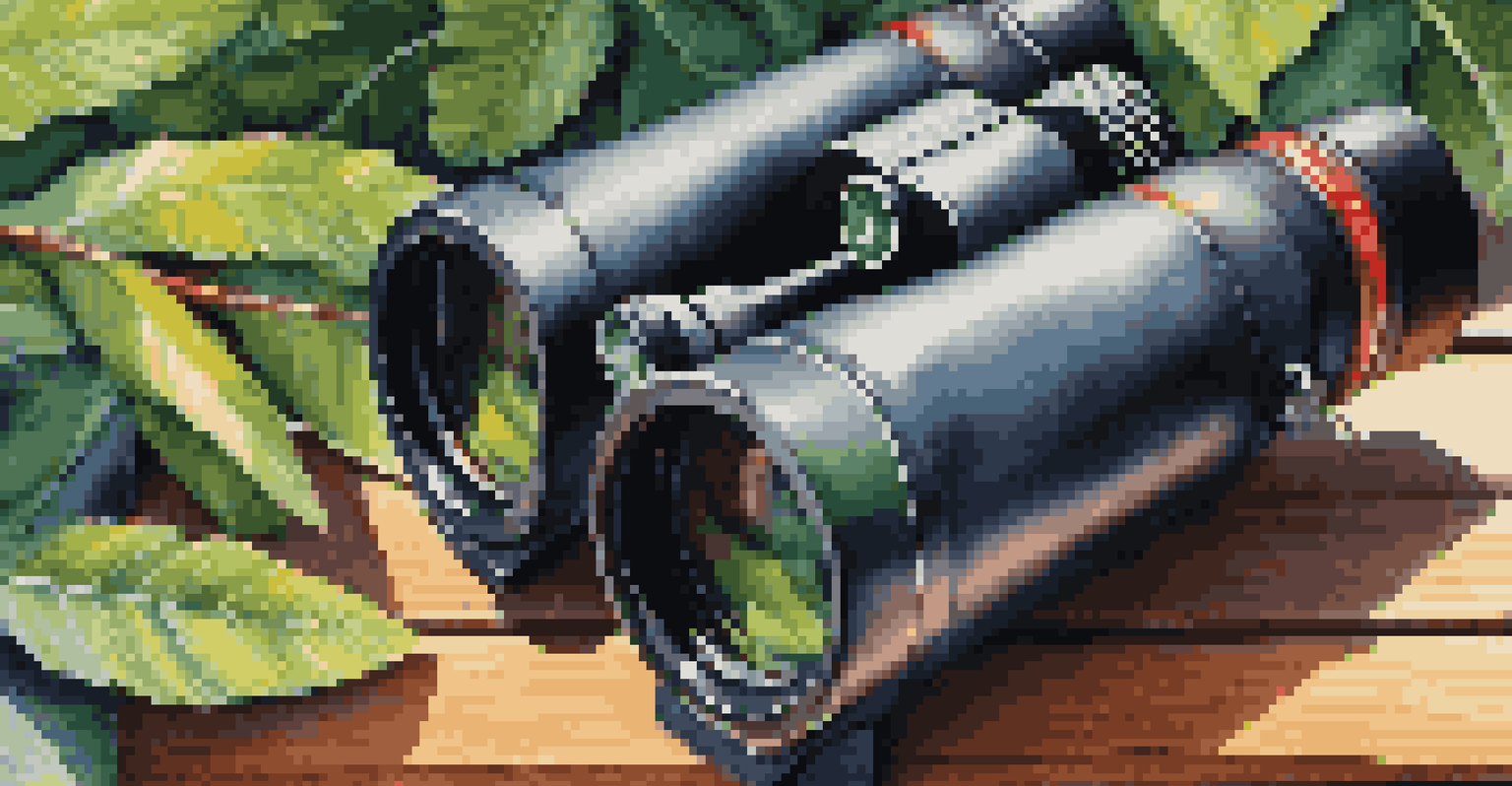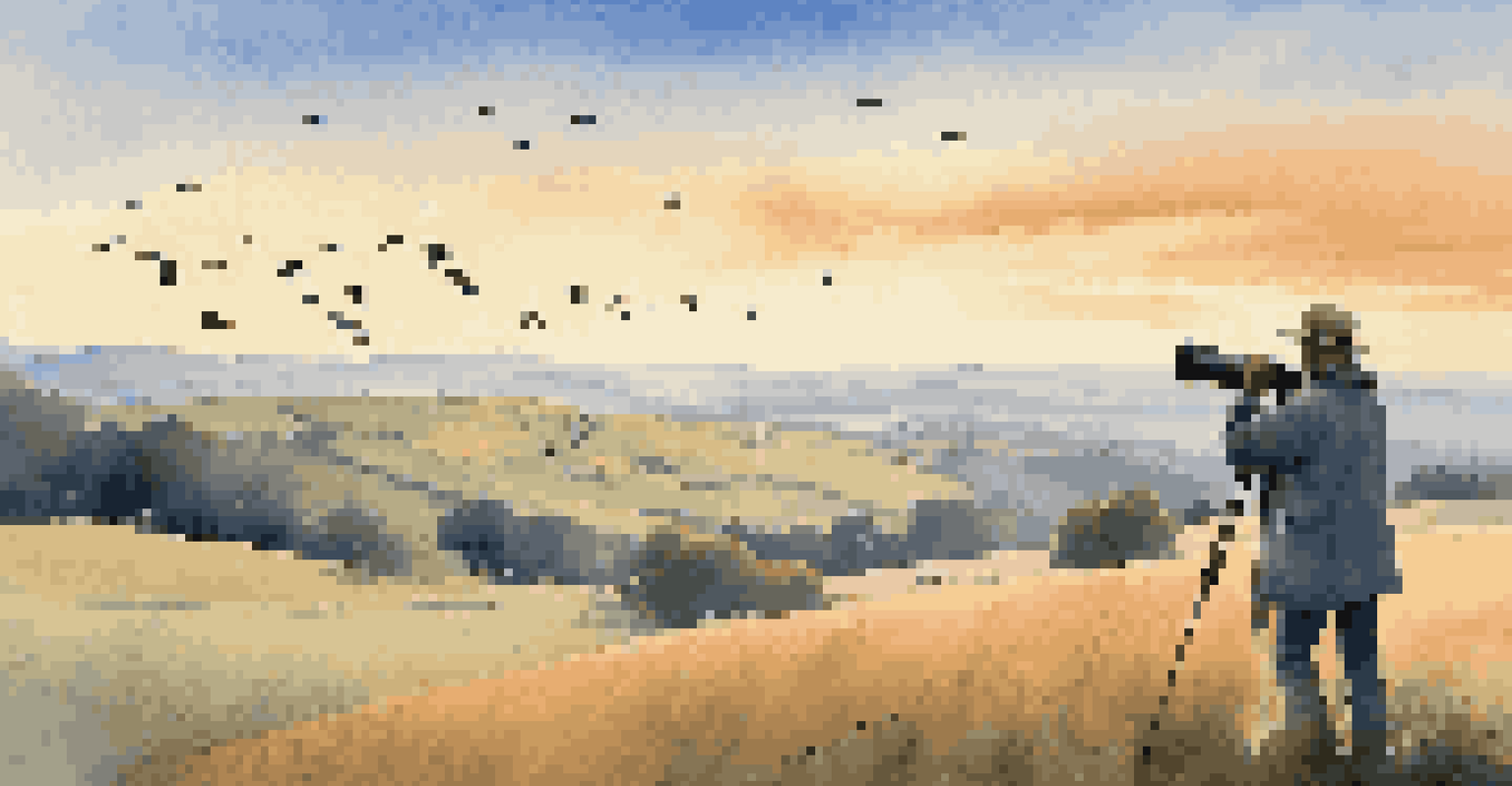Birdwatching Gear: Choosing the Right Binoculars

Understanding Binocular Specifications for Birdwatching
When it comes to birdwatching, knowing binocular specifications can feel overwhelming. However, the key numbers to focus on are the magnification and the objective lens diameter, often expressed as 8x42. This means the binoculars magnify objects eight times and have a 42mm objective lens, which gathers light for clearer images. Understanding these basics will help you narrow down your choices effectively.
The bird is powered by its own life and by its motivation.
Another important factor is the field of view, which tells you how wide an area you can see through the binoculars. A wider field of view is beneficial for tracking fast-moving birds. Additionally, consider the eye relief, especially if you wear glasses, as this will determine how comfortably you can view through the binoculars.
Ultimately, these specifications set the foundation for your birdwatching experience. Taking the time to understand them will ensure you pick a pair of binoculars that enhance your time spent in nature, making each bird sighting a joy.
Choosing the Right Magnification for Your Needs
Magnification plays a crucial role in how you observe birds. For general birdwatching, binoculars with a magnification of 8x or 10x strike a great balance. An 8x magnification offers a wider field of view, making it easier to spot birds in motion, while a 10x magnification allows for more detailed observations of distant species.

However, higher magnification also comes with a trade-off, like reduced stability. The more you magnify, the shakier your view can become, especially if you're not using a tripod. Therefore, consider how you plan to use your binoculars in the field—do you need to track fast flyers or observe perched birds?
Key Binocular Specs for Birdwatching
Understanding magnification, objective lens diameter, and field of view is crucial for choosing the right binoculars for birdwatching.
Ultimately, the best magnification is one that matches your birdwatching style. By weighing the pros and cons of both 8x and 10x options, you can find the perfect fit for your adventures.
The Importance of Objective Lens Diameter
The objective lens diameter significantly affects the brightness and clarity of your images. Larger lenses, like those in 10x42 binoculars, allow more light to enter, which is particularly beneficial during dawn or dusk when many birds are active. This can make a world of difference in spotting those elusive species.
In every walk with nature one receives far more than he seeks.
Conversely, smaller lenses are lighter and more compact, making them easier to carry on long hikes. If you plan to do a lot of walking, you might prioritize portability over maximum light-gathering capability. It's all about finding that sweet spot based on your birdwatching habits.
In essence, consider your typical birdwatching environment when choosing the objective lens diameter. Whether you prefer to venture out at twilight or during bright mid-morning, the right lens size will enhance your experience.
Understanding Field of View for Birdwatching
The field of view (FOV) indicates how wide an area you can see through the binoculars. For birdwatching, a wider FOV is advantageous, as it allows you to track birds more easily, especially when they are in flight. For instance, a binocular with a FOV of 400 feet at 1,000 yards will enable you to scan a larger area without losing sight of your feathered friends.
A narrow field of view can make it challenging to locate birds quickly, which can be frustrating when they flit from branch to branch. As a general rule, look for binoculars that offer a minimum of 300 feet FOV for birdwatching, ensuring you have enough visibility to spot and track movement.
Importance of Eye Relief
Evaluating eye relief ensures comfortable viewing, especially for those who wear glasses, enhancing the overall birdwatching experience.
Ultimately, understanding FOV helps you choose binoculars that enhance your birdwatching experience. A wider view not only makes it easier to find birds but also adds to the enjoyment of observing their natural behaviors.
Evaluating Eye Relief for Comfortable Viewing
Eye relief is the distance from the eyepiece to your eye where you can see the entire field of view. This is especially important for those who wear glasses, as inadequate eye relief can lead to uncomfortable viewing experiences. Binoculars with an eye relief of at least 15mm are generally recommended for comfortable observation with glasses.
If you don't wear glasses, you still want to consider eye relief to avoid straining your eyes during long sessions. A comfortable eye relief not only allows for a full view but also enhances your overall birdwatching experience. It’s one of those often-overlooked features that can make a significant difference.
In short, take the time to evaluate the eye relief of potential binoculars. This will ensure you can enjoy hours of birdwatching without discomfort, allowing you to focus on the beauty of nature.
Weight and Portability: Finding the Right Balance
When birdwatching, you'll likely be on the move, so weight and portability are key factors in choosing binoculars. Heavier binoculars may provide better optics, but they can become cumbersome during long hikes. Conversely, lightweight binoculars are easier to carry but may compromise on image quality or durability.
Consider how you plan to use your binoculars—will you be hiking through dense forests or standing still in a birdwatching hide? If you enjoy exploring, a compact and lightweight option might be best, while those who prefer stationary observation can afford to carry slightly heavier models.
Balancing Weight and Performance
Finding the right balance between the weight of binoculars and their optical performance is essential for comfortable and effective birdwatching.
Ultimately, finding the right balance between weight and performance is essential. By evaluating your typical birdwatching scenarios, you can select binoculars that won't weigh you down while still delivering the quality you need.
Budgeting for Binoculars: Quality vs. Cost
When it comes to choosing binoculars, your budget is an essential factor. While there are excellent options at various price points, investing in a quality pair can significantly enhance your birdwatching experience. Generally, you can find good binoculars starting around $100, but spending a bit more can yield better optics and durability.
Consider your frequency of use and the type of birdwatching you plan to do. If you’re a casual observer, a mid-range pair may suffice. However, if you’re committed to the hobby, investing in a higher-quality model can pay off in better clarity, brightness, and overall enjoyment.

Ultimately, set a budget that reflects your needs and stick to it. Remember, the right binoculars can make all the difference, so choose wisely to ensure you get the most out of your birdwatching adventures.